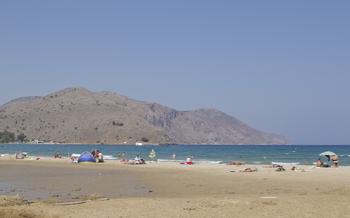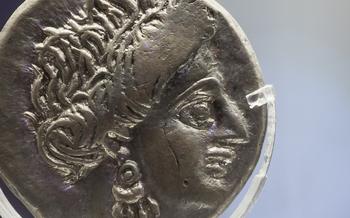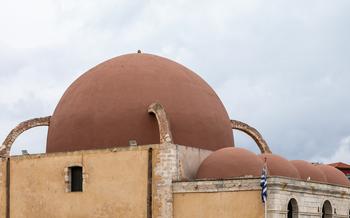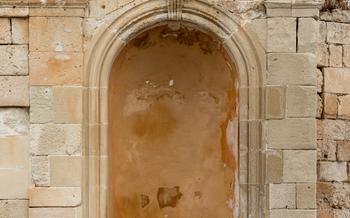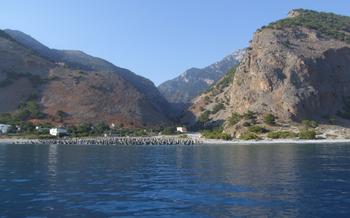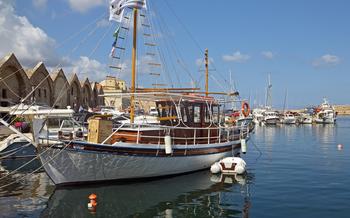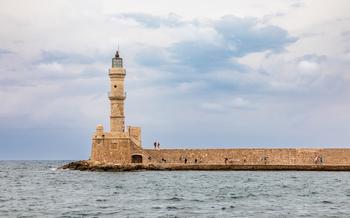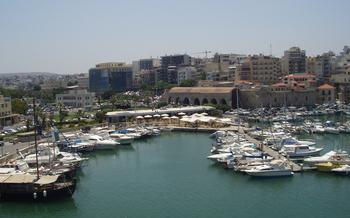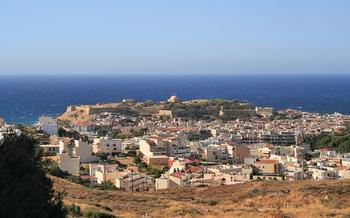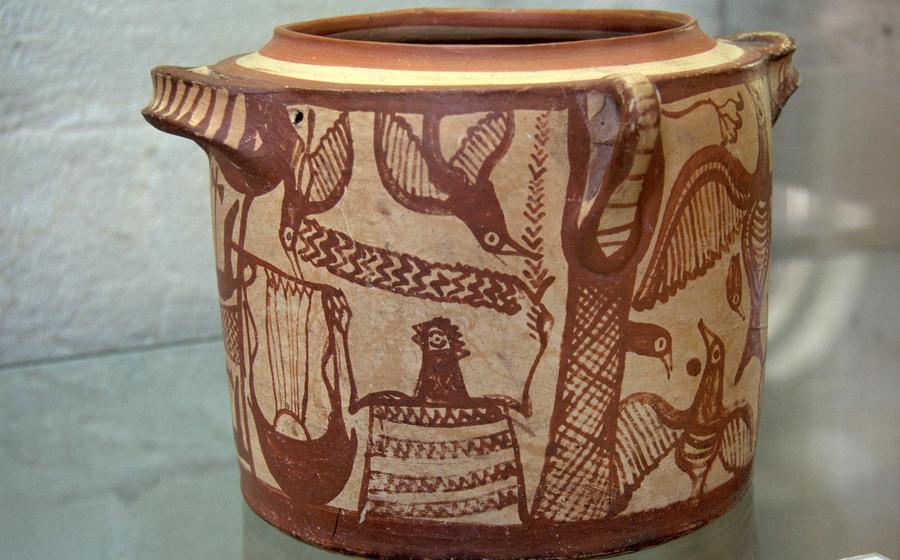
Ancient Aptera
- Geographical Location:
- Architectural Marvels
- Urban Planning
- Mythology and Legends
- Artistic Treasures
- Panoramic Views
- Archaeological Explorations
- Interactive Experiences
- Cultural Events
- Local Cuisine
- Souvenirs and Shopping
- Photography Opportunities
- Accessibility and Facilities
- Insider Tip: Uncovering the Hidden Gem of Megala Chorafia
Geographical Location:
Aptera's geographical location is remarkable, perched on a hilltop overlooking the mesmerizing Souda Bay. This strategic position offered the ancient city control over the surrounding region and the vital trade routes that passed through the bay. Today, Aptera's proximity to the modern city of Chania, approximately 13 kilometers to the east, makes it easily accessible for visitors.
Reaching Aptera is straightforward, whether by car or public transportation. If driving, follow the signs from Chania along the well-maintained road leading to the site. Alternatively, regular buses depart from Chania to nearby villages, and from there, a short taxi ride or a pleasant walk will take you to Aptera.
Once you arrive at the site, you'll find ample parking spaces, allowing you to conveniently leave your vehicle and embark on your journey into the past. To enhance your visit further, nearby restaurants and cafes offer a delightful opportunity to savor traditional Cretan cuisine while enjoying the stunning views.
Architectural Marvels
Aptera's architectural legacy is a testament to the city's ingenuity and grandeur. Fortified walls and defensive structures, once impenetrable, still stand as silent guardians of the city's past. The ancient theater, a masterpiece of acoustic design, invites visitors to imagine the echoes of ancient dramas and performances. Among the ruins, the remains of temples, houses, workshops, and other structures offer glimpses into the daily lives of Aptera's inhabitants. The unique architectural features and construction techniques employed, such as the use of massive stone blocks and intricate masonry, showcase the exceptional craftsmanship of the ancient builders. Aptera's architecture stands as a testament to the city's enduring legacy, blending history, art, and engineering in a captivating display of ancient prowess.
Urban Planning
Aptera's urban planning reflects the sophisticated principles employed by ancient civilizations. The city was designed with a grid-like street system that ensured efficient movement and organization. Water management systems, including aqueducts and cisterns, provided a reliable water supply to the city's inhabitants. Public spaces, such as the agora (marketplace) and the theater, served as gathering places for social, political, and cultural activities.
The influence of Roman and Hellenistic urban planning is evident in Aptera's layout. The Romans introduced the concept of straight, wide streets, while the Greeks contributed to the development of public spaces and monumental architecture. The city's fortifications, with their massive walls and towers, demonstrate the strategic importance of Aptera as a defensive stronghold.
Ongoing efforts are underway to reconstruct and restore Aptera's ancient city plan. Archaeological excavations have revealed new insights into the city's urban design, and restoration projects aim to preserve and showcase the unique features of this remarkable ancient site.
Mythology and Legends
Aptera is steeped in ancient myths and legends that add to its allure. One of the most famous tales is that of Talos, the bronze giant who guarded the city. According to legend, Talos was created by Hephaestus, the god of fire and metalworking, at the request of Minos, the powerful king of Crete. Talos was an unstoppable force, patrolling the coastline and throwing boulders at any ship that dared to approach. He was eventually defeated by the Argonauts, who used a clever ruse to trick him.
Another legend associated with Aptera is that of the Oracle of Apollo. It is said that the oracle, a priestess who delivered prophecies, resided in a temple dedicated to Apollo on the hilltop. People from all over the ancient world would come to consult the oracle, seeking guidance and wisdom. The oracle's prophecies were highly respected, and her words were often sought after by kings and rulers.
Artistic Treasures
Aptera has yielded a wealth of impressive artifacts that provide valuable insights into the artistic and cultural heritage of the ancient city. Among the most notable discoveries are finely crafted sculptures, intricately painted pottery, and exquisite jewelry. The sculptures, often depicting mythological figures or scenes from everyday life, showcase the exceptional skill and artistry of Aptera's sculptors. The pottery, ranging from simple utilitarian vessels to elaborately decorated vases, displays a diverse array of styles and techniques. The jewelry, made from precious metals and adorned with gemstones, reflects the high level of craftsmanship and sophistication achieved by Aptera's artisans. These treasures offer a tangible connection to the past, allowing visitors to appreciate the artistic achievements of this remarkable ancient city.
The unique artistic style of Aptera's artifacts is characterized by its attention to detail, harmonious proportions, and expressive forms. The sculptures, for example, often convey a sense of movement and emotion through their dynamic poses and intricate features. The pottery exhibits a wide range of decorative motifs, including geometric patterns, floral designs, and scenes from mythology. The jewelry, with its delicate filigree work and intricate settings, showcases the skill and artistry of Aptera's goldsmiths.
Many of the artifacts discovered at Aptera are housed in museums and archaeological collections around the world, where they can be viewed and appreciated by visitors. The Archaeological Museum of Chania, located in the city of Chania, displays a significant collection of artifacts from Aptera, including sculptures, pottery, and jewelry. The museum provides visitors with an opportunity to admire the artistic treasures of Aptera and gain a deeper understanding of the city's rich history and culture.
Panoramic Views
Aptera's hilltop location offers breathtaking panoramic views that will leave you in awe. Gaze out over the mesmerizing Souda Bay, framed by the rugged White Mountains. The deep blue waters stretch out to the horizon, dotted with sailboats and fishing vessels. Take a moment to admire the picturesque villages that cling to the hillsides, each with its own unique charm. From this vantage point, you'll understand why Aptera was once a strategic stronghold, controlling access to the bay and the surrounding region.
On a clear day, you can even spot the distant island of Gavdos, the southernmost point of Europe. As the sun sets, the sky transforms into a canvas of vibrant colors, casting a warm glow over the landscape. Whether you're a nature enthusiast, a history buff, or simply someone who appreciates breathtaking views, Aptera will surely captivate your senses and leave you with lasting memories.
Archaeological Explorations
Aptera has been the subject of extensive archaeological excavations since the late 19th century. These excavations have uncovered a wealth of artifacts and structures that have shed light on the city's history and significance. Among the most notable discoveries are the well-preserved ancient theater, which is one of the largest in Crete, and the remains of a temple dedicated to the goddess Artemis. Other important finds include fortifications, houses, workshops, and a complex water management system.
The ongoing excavations at Aptera are conducted by a team of archaeologists from the University of Crete. Their work has focused on uncovering new areas of the city, such as the residential districts and the agora (marketplace). They have also been working to restore and conserve the existing structures, including the theater and the temple of Artemis.
The archaeological work at Aptera has provided valuable insights into the life and culture of this ancient city. It has also helped to raise awareness of the importance of preserving and protecting our cultural heritage.
Interactive Experiences
Aptera offers visitors a range of interactive experiences that bring history to life. Guided tours led by knowledgeable experts provide insights into the site's past and its significance. Visitors can also participate in educational workshops that allow them to learn about ancient crafts and techniques. For a truly immersive experience, reenactments and living history demonstrations showcase daily life in Aptera during ancient times.
Technology also plays a role in enhancing the visitor experience. Augmented reality and virtual reality applications offer interactive ways to explore the site's history and architecture. Through these technologies, visitors can see reconstructions of ancient buildings, witness historical events, and interact with virtual characters.
I had the opportunity to participate in a guided tour and an augmented reality experience at Aptera. The tour guide's passion and knowledge brought the site's history to life, while the augmented reality app allowed me to visualize the ancient city in its former glory. It was an unforgettable experience that deepened my understanding and appreciation of Aptera's rich past.
Cultural Events
Aptera and its surroundings come alive with cultural events, festivals, and performances that celebrate the rich heritage of the region. Immerse yourself in the vibrant atmosphere of these events and experience the authentic spirit of Crete.
The Aptera Festival, held annually in the summer, is a highlight of the cultural calendar. This festival showcases traditional Cretan music, dance, and theater, along with local artisans and food vendors. Don't miss the chance to witness the enchanting performances and join in the lively festivities.
Throughout the year, various cultural events take place in the nearby villages and towns. From traditional music concerts and dance performances to art exhibitions and historical reenactments, there's always something to experience. Check local listings or inquire at the visitor information centers for the latest event schedules.
Attending cultural events in Aptera is a fantastic way to connect with the local community and gain a deeper understanding of Cretan culture. Embrace the opportunity to immerse yourself in the vibrant traditions and folklore of this enchanting region.
Local Cuisine
After a day of exploring the ancient ruins, indulge your taste buds with the flavors of traditional Cretan cuisine. Several nearby restaurants and tavernas offer a delightful array of dishes that showcase the region's culinary heritage. Don't miss the opportunity to savor signature dishes like dakos, a refreshing salad made with barley rusks, tomatoes, and mizithra cheese; gamopilafo, a celebratory rice dish with lamb or chicken; or sfakianes pites, delicious pies filled with local greens and cheese.
Vegetarians and vegans will also find plenty of options to satisfy their cravings. Ask the friendly locals for recommendations or look for dishes featuring fresh seasonal produce, such as the famed Cretan tomatoes, olives, and herbs. Whether you choose to dine at a traditional taverna with live music or a modern restaurant with a creative twist, you're sure to have a memorable culinary experience in the vicinity of Aptera.
Souvenirs and Shopping
After exploring the ancient ruins and soaking in the history of Aptera, visitors can indulge in a bit of shopping to take home a piece of their experience. The surrounding towns and villages offer a variety of shops and markets where visitors can find unique souvenirs and local products.
In the nearby town of Chania, visitors can find a vibrant market called the Chania Central Market. This bustling marketplace offers a wide array of goods, including fresh produce, local cheeses, herbs, spices, and traditional Cretan handicrafts. Visitors can also find souvenirs such as ceramics, leather goods, and jewelry inspired by the region's rich history and culture.
For those seeking one-of-a-kind souvenirs, the village of Vamos, located just a short drive from Aptera, is home to a thriving community of artists and artisans. Visitors can explore the narrow streets and discover hidden galleries, studios, and workshops where they can purchase handmade pottery, paintings, sculptures, and other unique creations.
Remember to support local businesses and artisans when shopping for souvenirs. By purchasing handmade goods and locally produced products, visitors not only take home a piece of Aptera's history but also contribute to the preservation of traditional crafts and the local economy.
Photography Opportunities
Aptera offers a wealth of picturesque spots that are a photographer's paradise. The ancient ruins, set against the backdrop of the rugged Cretan landscape and the sparkling Souda Bay, create a stunning visual tapestry. The best time to capture the essence of Aptera is during the golden hours of sunrise and sunset when the warm light casts a magical glow on the ancient stones.
For capturing panoramic shots, head to the highest point of the hilltop. From here, you can frame the entire site, with the Venetian fortress, the ancient theater, and the sprawling countryside beyond. For close-up shots of the intricate details of the ruins, explore the nooks and crannies of the site, where you'll find weathered walls, crumbling columns, and expressive sculptures waiting to be immortalized through your lens.
Consider joining a photography workshop or tour to learn from experienced professionals. These workshops often provide expert guidance on composition, lighting, and post-processing techniques, helping you capture the essence of Aptera's ancient beauty.
My favorite spot for photography at Aptera is the ancient theater. The sweeping rows of stone seats, framed by the backdrop of the White Mountains, create a dramatic and evocative image. I recommend experimenting with different angles and perspectives to capture the grandeur of this ancient performance space.
Accessibility and Facilities
Aptera is committed to providing an accessible and enjoyable experience for all visitors. Wheelchair-accessible ramps and pathways allow visitors with disabilities to navigate the site with ease. Restrooms and seating areas are conveniently located throughout the archaeological park, ensuring comfort and convenience for all. Drinking water fountains are also available to keep visitors hydrated during their exploration.
At the entrance of the site, you'll find a modern visitor center that serves as a valuable resource for all visitors. Here, you can obtain maps, brochures, and information about the ongoing excavations and research at Aptera. Knowledgeable staff members are on hand to answer questions, provide guidance, and assist with any special needs or requests.
For those seeking a deeper understanding of Aptera's rich history and cultural significance, guided tours are available in multiple languages. These tours, led by experienced guides, offer insightful commentary and bring the ancient city to life, allowing visitors to fully appreciate its grandeur and legacy.
With its accessible features, visitor-friendly amenities, and knowledgeable staff, Aptera ensures that all visitors have a memorable and enriching experience while exploring this captivating archaeological wonder.
Insider Tip: Uncovering the Hidden Gem of Megala Chorafia
Beyond the ancient ruins of Aptera lies a hidden gem waiting to be discovered – the picturesque village of Megala Chorafia. Nestled amidst rolling hills and olive groves, this charming village offers a glimpse into the authentic Cretan way of life. Stroll through its narrow, winding streets adorned with traditional stone houses and colorful bougainvillea. Engage with the friendly locals, who are always eager to share stories and offer warm hospitality. Don't miss the opportunity to savor delicious homemade dishes at one of the local tavernas, where you can indulge in traditional Cretan cuisine while enjoying breathtaking views of the surrounding landscape. Megala Chorafia is a true hidden gem that provides a unique and immersive experience for those seeking to explore the heart of Crete.
